The Apple iPad Review (2012)
by Vivek Gowri & Anand Lal Shimpi on March 28, 2012 3:14 PM ESTGPU Performance
All of our discussions around the new iPad and its silicon thus far have been in the theoretical space. Unfortunately the state of Android/iOS benchmarking is abysmal at best today. Convincing game developers to include useful benchmarks and timedemo modes in their games is seemingly impossible without a suitably large check. I have no doubt this will happen eventually, but today we're left with some great games and no way to benchmark them.
Without suitable game benchmarks, we rely on GLBenchmark quite a bit to help us in evaluating mobile GPU performance. Although even the current most stressful GLBenchmark test (Egypt) is a far cry from what modern Android/iOS games look like, it's the best we've got today.
We'll start out with the synthetic tests, which should show us roughly a 2x increase in performance compared to the iPad 2. Remember the PowerVR SGX 543MP4 simply bundles four SGX 543 cores instead of two. Since we're still on a 45nm LP process, GPU clocks haven't increased so we're looking at a pure doubling of virtually all GPU resources.
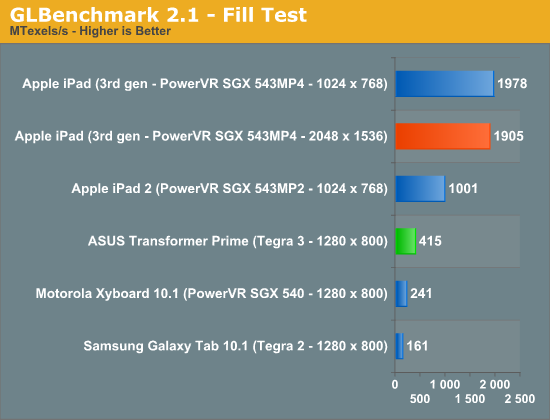
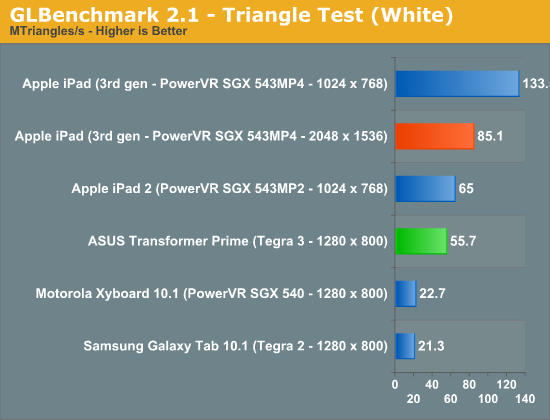
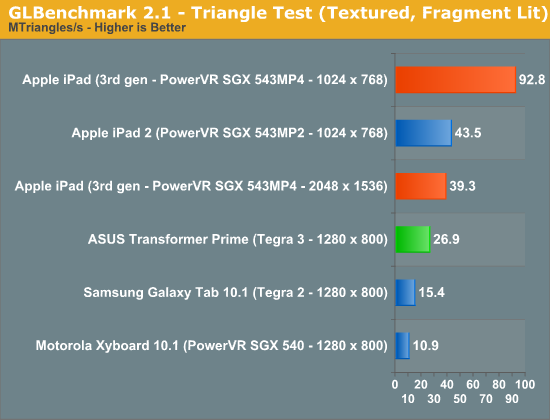
Indeed we see a roughly 2x increase in triangle and fill rates. Below we have the output from GLBenchmark's low level tests. Pay particular attention to how, at 1024 x 768, performance doubles compared to the iPad 2 but at 2048 x 1536 performance can drop to well below what the iPad 2 was able to deliver at 10 x 7. It's because of this drop in performance at the iPad's native resolution that we won't see many (if any at all), visually taxing games run at anywhere near 2048 x 1536.
| GLBenchmark 2.1.3 Low Level Comparison | ||||||
| iPad 2 (10x7) | iPad 3 (10x7) | iPad 3 (20x15) | ASUS TF Prime | |||
| Trigonometric test—vertex weighted |
35 fps
|
60 fps
|
57 fps
|
47 fps
|
||
| Trigonometric test—fragment weighted |
7 fps
|
14 fps
|
4 fps
|
20 fps
|
||
| Trigonometric test—balanced |
5 fps
|
10 fps
|
2 fps
|
9 fps
|
||
| Exponential test—vertex weighted |
59 fps
|
60 fps
|
60 fps
|
41 fps
|
||
| Exponential test—fragment weighted |
25 fps
|
49 fps
|
13 fps
|
18 fps
|
||
| Exponential test—balanced |
19 fps
|
37 fps
|
8 fps
|
7 fps
|
||
| Common test—vertex weighted |
49 fps
|
60 fps
|
60 fps
|
35 fps
|
||
| Common test—fragment weighted |
8 fps
|
16 fps
|
4 fps
|
28 fps
|
||
| Common test—balanced |
6 fps
|
13 fps
|
2 fps
|
12 fps
|
||
| Geometric test—vertex weighted |
57 fps
|
60 fps
|
60 fps
|
27 fps
|
||
| Geometric test—fragment weighted |
12 fps
|
24 fps
|
6 fps
|
20 fps
|
||
| Geometric test—balanced |
9 fps
|
18 fps
|
4 fps
|
9 fps
|
||
| For loop test—vertex weighted |
59 fps
|
60 fps
|
60 fps
|
28 fps
|
||
| For loop test—fragment weighted |
30 fps
|
57 fps
|
16 fps
|
42 fps
|
||
| For loop test—balanced |
22 fps
|
43 fps
|
11 fps
|
15 fps
|
||
| Branching test—vertex weighted |
58 fps
|
60 fps
|
60 fps
|
45 fps
|
||
| Branching test—fragment weighted |
58 fps
|
60 fps
|
30 fps
|
46 fps
|
||
| Branching test—balanced |
22 fps
|
43 fps
|
16 fps
|
16 fps
|
||
| Array test—uniform array access |
59 fps
|
60 fps
|
60 fps
|
60 fps
|
||
| Fill test—Texture Fetch |
1001483136 texels/s
|
1977874688
texels/s |
1904501632
texels/s |
415164192
texels/s |
||
| Triangle test—white |
65039568
triangles/s |
133523176
triangles/s |
85110008
triangles/s |
55729532
triangles/s |
||
| Triangle test—textured |
56129984
triangles/s |
116735856
triangles/s |
71362616
triangles/s |
54023840
triangles/s |
||
| Triangle test—textured, vertex lit |
45314484
triangles/s |
93638456
triangles/s |
46841924
triangles/s |
28916834
triangles/s |
||
| Triangle test—textured, fragment lit |
43527292
triangles/s |
92831152
triangles/s |
39277916
triangles/s |
26935792
triangles/s |
||
GLBenchmark also includes two tests designed to be representative of a workload you could see in an actual 3D game. The older Pro test uses OpenGL ES 1.0 while Egypt is an ES 2.0 test. These tests can either run at the device's native resolution with vsync enabled, or rendered offscreen at 1280 x 720 with vsync disabled. The latter offers us a way to compare GPUs without device screen resolution creating unfair advantages.
Unfortunately there was a bug in the iOS version of GLBenchmark 2.1.2 that resulted in all on-screen benchmarks running at 1024 x 768 rather than the new iPad's native 2048 x 1536 resolution. This is why all of the native GLBenchmark scores from the new iPad are capped at 60 fps. It's not because the new GPU is fast enough to render at speeds above 60 fps at 2048 x 1536, it's because the benchmark is actually showing performance at 1024 x 768. Luckily, GLBenchmark 2.1.3 fixes this problem and delivers results at the new iPad's native screen resolution:

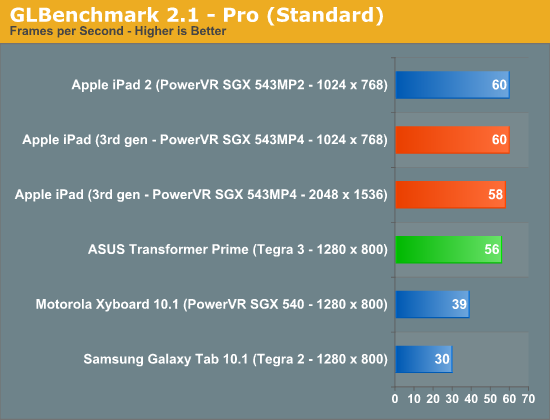
Surprisingly enough, the A5X is actually fast enough to complete these tests at over 50 fps. Perhaps this is more of an indication of how light the Egypt workload has become, as the current crop of Retina Display enhanced 3D titles for the iPad all render offscreen to a non-native resolution due to performance constraints. The bigger takeaway is that with the 543MP4 and a quad-channel LP-DDR2 interface, it is possible to run a 3D game at 2048 x 1536 and deliver playable frame rates. It won't be the prettiest game around, but it's definitely possible.
The offscreen results give us the competitive analysis that we've been looking for. With a ~2x die size advantage, the fact that we're seeing a 2-3x gap in performance here vs. NVIDIA's Tegra 3 isn't surprising:
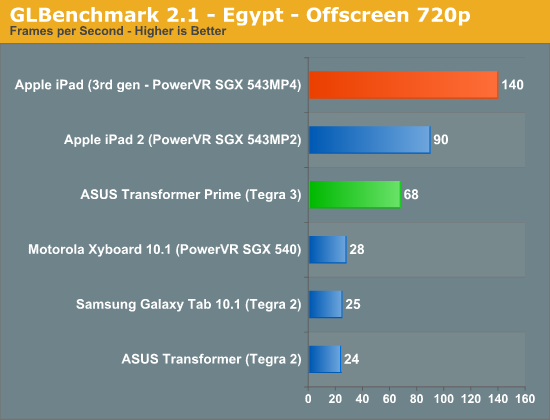
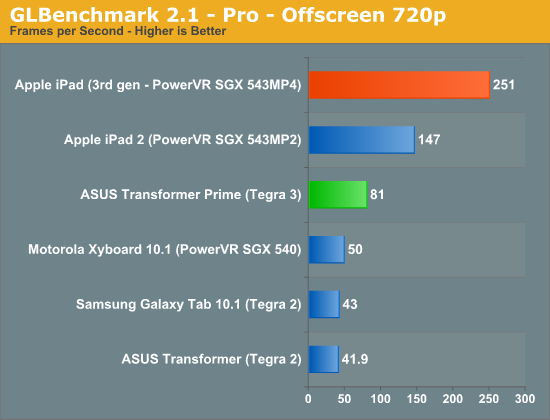
The bigger worry is what happens when the first 1920 x 1200 enabled Tegra 3 tablets start shipping. With (presumably) no additional GPU horsepower or memory bandwidth under the hood, we'll see this gap widen.










234 Comments
View All Comments
ananduser - Thursday, March 29, 2012 - link
Imagination does own the fastest GPU available today. The current Tegra offerings cannot match it but nvidia goes a different way. They will start piling CUDA cores like they do on the desktop GPU front. Say you'll have in the future a better quad core from Imagination and nvidia's GPU will consist of something like 64 CUDA cores.zorxd - Thursday, March 29, 2012 - link
The problem is that you can't plug an iDevice to a computer a transfer files as you would on a USB thumb drive without iTunes. That's a major disadvantage.Also if you excluse Apple's SoC, what company makes better mobile GPU than Nvidia? The Mali 400 MP4 is good too (about on par it seems), but I wouldn't say that Tegra 3 is the bottom of the performance barrel. You seems to forget the major players of Qualcomm and TI.
darkcrayon - Thursday, March 29, 2012 - link
You can however transfer files to any number of apps via WIFI or with cloud solutions without needing iTunes though. I'd call it a "disadvantage" but not a major one.You're right the Tegra 3 isn't, I was speaking more generally considering how the Tegra 2 performed vs. the competition as well. It just seemed out of place to choose a tablet because you "love nVidia GPUs" when nVidia has not necessarily put out a spectacular GPU in any ARM SoC.
merajaan - Wednesday, March 28, 2012 - link
You guys must be commended on this review. You covered all the areas that I wanted to know about and really didn't leave one stone unturned. I applaud the depth and detail and appreciate that you didn't rush your review out for launch day like many other sites. I also appreciate the unbiased nature in which the review was written and your honest viewpoints!Anand Lal Shimpi - Thursday, March 29, 2012 - link
Thank you for the kind words :)Take care,
Anand
repoman27 - Thursday, March 29, 2012 - link
So you've gone and included a lovely example of how the AnandTech icon looks at 72 and 144 dpi... How's about including <link rel="apple-touch-icon" sizes="144x144" href="icon144.png"/> on this site so we can have a proper icon when we add an AnandTech web clip to our home screens?adrien - Thursday, March 29, 2012 - link
Still reading the review (and liking it), I'm wondering about thermals.What was the temperature of the room? Could you try with different room temperatures? (I'm wondering how it'll change when it gets 15°C hotter and how it'll fare with sun shining on it).
Is there CPU or GPU throttling when it starts heating? Do you know the SoC temp?
Thanks. :-)
Anand Lal Shimpi - Thursday, March 29, 2012 - link
The ambient temperature in the room was approximately 23C. An overheating condition will trigger an OS-wide warning, which I believe causes the system to shut down.I unfortunately don't have access to anything that could read the SoC temp.
Testing at different room temperatures is an interesting idea but one that would be difficult to accurately control without some serious equipment. I ran these tests side by side at the same time to avoid issues with a changing ambient temperature.
Take care,
Anand
adrien - Thursday, March 29, 2012 - link
Ok, thanks. With summer approaching (and very quickly in France), I guess we'll see real-world tests for the temperature in a few weeks anyway. ;-)scribby - Thursday, March 29, 2012 - link
Nice review :)I'm also wondering about thermals,
What was the brightness level when measuring the thermals on the new ipad?
Thank you.